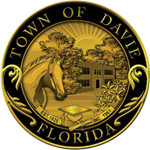
Table XII
TOWN OF DAVIE POLICE PENSION PLAN
Actuarial Assumptions and Actuarial Cost Method
1. Mortality:
For healthy participants, the PUB-2010 Headcount Weighted Safety Employee Mortality Table was used with separate rates for males and females.
For disabled participants, the 1985 Pension Disability Table was used with separate rates for males and females.
No provision was made for future mortality improvement.
50% of all pre-retirement deaths are assumed to be duty related.
2. Interest to be Earned by Fund:
6.95%, compounded annually, net of investment expenses.
3. Allowances for Expenses or Contingencies:
Estimated by net of investment fees paid during previous year.
4. Employee Withdrawal Rates:
Withdrawal rates were used in accordance with tables per the following illustrative example:
| Withdrawal Rates Per 100 Employees |
||
| Age | Male | Female |
| 20 | 8.4 | 14.0 |
| 25 | 5.6 | 8.4 |
| 30 | 3.9 | 5.6 |
| 35 | 2.8 | 3.9 |
| 40 | 1.7 | 2.8 |
| 45 | 1.1 | 1.7 |
| 50 | 0.2 | 1.1 |
| 55 & over | 0.0 | 0.0 |
5. Assumptions on Pensionable Overtime Hours
Each member is assumed to continue to work the same number of overtime hours as in the most recent plan year, subject to the 300 hours maximum, for each future year.
6. Disability Rates:
The 1985 Disability Study - Class 1 with separate male and female rates were used. 75% of disabilities assumed to be service incurred, 25% assumed to be non-service incurred.
7. Salary Increase Factors:
Current salaries were assumed to increase at a rate of 5.5% per year until retirement.
8. Rates of Retirement:
The following are the retirement rates assumed for the participants eligible for retirement:
|
||||||||||||||||||
However, active participants eligible for retirement that have less than 20 years of Benefit Service as of the valuation date are assumed to have a minimum of one year future service.
9. Asset Valuation Method:
The actuarial value of assets is determined by smoothing the differences between actual investment earnings and assumed investment return over three (3) years. This method was adopted effective October 1, 2007 with no phase-in. The resulting value would then be limited to between 80% and 120% of market value.
10. Actuarial Cost Method:
Normal Retirement, Termination, Disability and Pre-Retirement Death Benefits: Entry-Age-Actuarial Cost Method.
Under this method the normal cost for each active employee is the amount which is calculated to be a level percentage of pay that would be required annually from his date of hire to his retirement age to fund his estimated benefits, assuming the plan had always been in effect. The normal cost for the plan is the sum of the individual normal costs for all active participants. The actuarial accrued liability as of any valuation date for each active employee or inactive employee who is eligible to receive benefits under the plan is the excess of the actuarial present value of estimated future benefits over the actuarial present value of current and future normal costs. The unfunded actuarial accrued liability as of any valuation date is the excess of the actuarial accrued liability over the actuarial value of assets of the plan.
11. Marriage Assumptions:
100% of active participants were assumed married, with husbands three (3) years older than wives.
12. Valuation of Normal Form of Payment:
The normal form of payment is valued as an unreduced joint and 60% survivor annuity benefit for married members. For unmarried members, the normal form of payment is valued as a ten year certain and life annuity.
13. Changes from October 1, 2020 Actuarial Valuation:
The assumed fund investment return was changed from 7.40% to 6.95%, (net of investment expenses), compounded annually. Any existing amortization bases with a remaining amortization period greater than 20 years are reduced to 20 years, and all future amortization bases will be established with an amortization period of 20 years.


